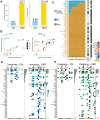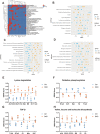Prediction of cellular targets in diabetic kidney diseases with single-cell transcriptomic analysis of db/db mouse kidneys
- PMID: 35809207
- PMCID: PMC10030752
- DOI: 10.1007/s12079-022-00685-z
Prediction of cellular targets in diabetic kidney diseases with single-cell transcriptomic analysis of db/db mouse kidneys
Abstract
Diabetic kidney disease is the leading cause of impaired kidney function, albuminuria, and renal replacement therapy (dialysis or transplantation), thus placing a large burden on health-care systems. This urgent event requires us to reveal the molecular mechanism of this disease to develop more efficacious treatment. Herein, we reported single-cell RNA sequencing analyses in kidneys of db/db mouse, an animal model for type 2 diabetes and diabetic kidney disease. We first analyzed the hub genes expressed differentially in the single cell resolution transcriptome map of the kidneys. Then we figured out the communication among the renal and immune cells in the kidneys. Data from this report may provide novel information for better understanding the cell-specific targets involved in the aetiologia of type 2 diabetic kidney disease and for cell communication and signaling between renal cells and immune cells of this complex disease.
Keywords: Diabetes; Diabetic kidney disease; End-stage renal disease; Proximal epithelial tubular cells; Single-cell RNA sequencing.
© 2022. The International CCN Society.
Conflict of interest statement
The authors declare no competing interests.
Figures







Similar articles
-
Sacubitril/valsartan treatment has differential effects in modulating diabetic kidney disease in db/db mice and KKAy mice compared with valsartan treatment.Am J Physiol Renal Physiol. 2021 Jun 1;320(6):F1133-F1151. doi: 10.1152/ajprenal.00614.2020. Epub 2021 Apr 19. Am J Physiol Renal Physiol. 2021. PMID: 33870733 Free PMC article.
-
Alterations in Protein Translation and Carboxylic Acid Catabolic Processes in Diabetic Kidney Disease.Cells. 2022 Mar 30;11(7):1166. doi: 10.3390/cells11071166. Cells. 2022. PMID: 35406730 Free PMC article.
-
An integrated network pharmacology and transcriptomic method to explore the mechanism of the total Rhizoma Coptidis alkaloids in improving diabetic nephropathy.J Ethnopharmacol. 2021 Apr 24;270:113806. doi: 10.1016/j.jep.2021.113806. Epub 2021 Jan 12. J Ethnopharmacol. 2021. PMID: 33444721
-
Diabetic kidney disease in the db/db mouse.Am J Physiol Renal Physiol. 2003 Jun;284(6):F1138-44. doi: 10.1152/ajprenal.00315.2002. Am J Physiol Renal Physiol. 2003. PMID: 12736165 Review.
-
Recent insights into diabetic renal injury from the db/db mouse model of type 2 diabetic nephropathy.Am J Physiol Renal Physiol. 2011 Feb;300(2):F301-10. doi: 10.1152/ajprenal.00607.2010. Epub 2010 Dec 8. Am J Physiol Renal Physiol. 2011. PMID: 21147843 Review.
Cited by
-
Evaluation of the efficacy of Abelmoschus manihot (L.) on diabetic nephropathy by analyzing biomarkers in the glomeruli and proximal and distal convoluted tubules of the kidneys.Front Pharmacol. 2023 Aug 1;14:1215996. doi: 10.3389/fphar.2023.1215996. eCollection 2023. Front Pharmacol. 2023. PMID: 37587982 Free PMC article.
-
The Role of Immune Cells in DKD: Mechanisms and Targeted Therapies.J Inflamm Res. 2024 Apr 6;17:2103-2118. doi: 10.2147/JIR.S457526. eCollection 2024. J Inflamm Res. 2024. PMID: 38601771 Free PMC article. Review.
-
Single-cell RNA sequencing in diabetic kidney disease: a literature review.Ren Fail. 2024 Dec;46(2):2387428. doi: 10.1080/0886022X.2024.2387428. Epub 2024 Aug 4. Ren Fail. 2024. PMID: 39099183 Free PMC article. Review.
-
GoM DE: interpreting structure in sequence count data with differential expression analysis allowing for grades of membership.Genome Biol. 2023 Oct 19;24(1):236. doi: 10.1186/s13059-023-03067-9. Genome Biol. 2023. PMID: 37858253 Free PMC article.
-
Interaction between Plasma Metabolomics and Intestinal Microbiome in db/db Mouse, an Animal Model for Study of Type 2 Diabetes and Diabetic Kidney Disease.Metabolites. 2022 Aug 23;12(9):775. doi: 10.3390/metabo12090775. Metabolites. 2022. PMID: 36144180 Free PMC article.
References
Grants and funding
LinkOut - more resources
Full Text Sources
Miscellaneous

